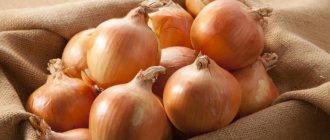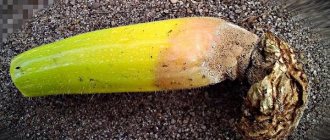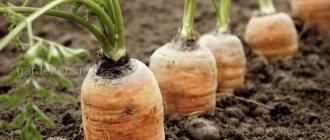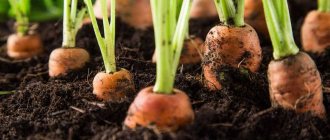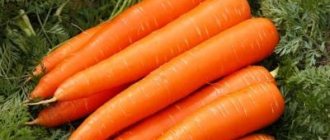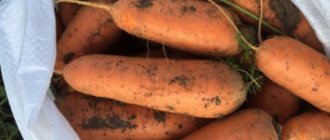Proper storage of carrot harvest is a difficult problem for gardeners. It is especially acute in the absence of basements and cellars.
One way to solve the problem is to keep the carrots in the ground until spring. With proper organization, root crops can easily survive even severe frosts.
Let’s take a closer look at how to properly store carrots in the ground until spring.
Storing root vegetables: myth or reality?
Preserving vegetables throughout the winter is quite possible if appropriate conditions are created so that the vegetables do not spoil or lose their taste.
Carrots are a cold-resistant crop and do not lose their quality even with slight frosts in the autumn. This quality allows you to even leave the crop on the ground.
Storage conditions for carrots:
- humidity – about 95%;
- temperature – about 0ºС.
In addition to compliance with external conditions, requirements are also imposed on the vegetable itself:
- late-ripening variety;
- achieving full maturity;
- absence of physical damage and illness.
The vegetable itself has a thin peel that is susceptible to external influences. If the storage organization technology is violated, root crops begin to lose natural moisture and deteriorate.
Harvesting and preparing it for storage
The success of preserving the root crop and its beneficial properties depends on the carrot variety, growing conditions and region, and harvest time . Root crops are harvested in September, 90-120 days after planting.
You should dig up the root crop with a pitchfork or garden shovel . When tearing out the vegetable by the tops, make sure that the fruit does not break.
When digging, avoid mechanical damage to root crops. Carrots with scratches, cuts or breaks cannot be stored for long periods of time.
Harvest carrots in dry weather. When digging, be careful not to damage the skin or tear off the tops
It is important to know that harvesting should be carried out in dry weather . This will completely dry the vegetables and prevent large-scale rotting. To dry, place the root vegetables on a wooden surface under a canopy (on the veranda, loggia, in the garage) or outside (subject to good weather). An important condition for drying is constant circulation of fresh air and minimal humidity. The duration of drying depends on the initial state of the root crops, but on average it is 2-5 days.
To dry carrots, place them on straw in the fresh air. Make sure that the vegetables are not exposed to direct sunlight during drying and that they do not heat up.
Choice of variety and preparation features
Not all varieties are suitable for storage in the ground, but only late ripening ones, including hybrid ones. They must be adapted to climatic conditions and have good cold resistance.
The most popular among them include:
- Shantanay;
- "Incomparable";
- Royal Chantanay;
- Perfection;
- Sirkana F1 and others.
The choice of carrot seeds, which are intended for storage in the ground, should take into account the characteristics of the growing area.
Even at the stage of choosing a place for a garden bed and seeds, it should be taken into account that the crop will remain in the ground throughout the winter. Requirements for the site:
- The territory should not be in a zone of flooding with water (groundwater or as a result of heavy rainfall).
- Protection from rodents is required.
- The shelter must be secure enough to prevent the soil from freezing.
- The soil should not be infested with pests.
- The area for carrots should not interfere with spring sowing.
Even if the unharvested, unsheathed and unharvested carrot crop is caught in frost, the harvest is not in danger.
There are 2 ways to preserve carrots in the ground without using a special room:
- Directly on the garden bed.
- In a hole in the ground.
Each of the presented options has its own pros and cons.
Features of wintering root crops
The method of storing carrots in the ground does not require special storage facilities . Before storing vegetables for winter storage, you should study the area where the root crops will winter.
Taking into account the requirements for this area and the peculiarities of storing carrots in the ground, it is recommended to follow the rules:
- The place should not be flooded with water, especially in the spring with heavy rainfall.
- Make the covering layer thick enough to protect the ground from freezing.
- Protect from rodent attacks.
- The soil must be healthy, free from soil diseases, and not infested with mole crickets, wireworms and other pests.
- Healthy, high-quality vegetables should be left for the winter.
- The allocated area should not interfere with spring work in the garden.
How to properly store crops in the garden?
Since carrots are resistant to low temperatures, they can be left directly in the garden bed where they grew. In winter, severe frosts are possible, so it is better to organize additional shelter.
This method is acceptable under the following conditions:
- there is no time to harvest;
- there are no conditions for storage - there is no cellar or other suitable room.
Disadvantages of storing vegetables in the ground unharvested:
- possible damage to root crops by rodents;
- there is a possibility of damage to the crop by pests remaining in the soil;
- there is no confidence that all the vegetables left in the beds are of good quality, since it is impossible to inspect them before storage;
- In very snowy winters it can be difficult to get to the carrots.
To create a shelter right in the garden you will need:
- black polyethylene;
- roofing felt;
- boards or sand.
Procedure:
- Eliminate weeds in the carrot bed.
- If the tops remain green until late autumn, they need to be cut off. The tail that remains should be no more than 20-30 mm.
- Place a row of boards on top or pour wet sand in a layer of 20-30 mm.
- If the option with sand is chosen, then a layer of black polyethylene is placed on top of it before the onset of frost.
- Add a layer of mulch.
- Cover with a layer of film and roofing felt to protect against low temperatures.
It is necessary to ensure that the coating is well secured; it must be resistant even to strong gusts of wind.
How to preserve fruits
To preserve vitamins and appearance, the fruit must be properly processed. Is it possible to store carrots if there is no special cellar? Can.
In this case, approach the variety more carefully; root crops that ripen as late as possible are suitable. Try to observe the temperature regime - ideally it should be at +1 or +2 0C.
Pay attention to humidity; carrots like it when the storage room has 90 or even 95% humidity.
Leave it in a hole for the winter
The method of storing carrots in an earthen pit involves preliminary digging up the crop. This option for preserving root crops can be adopted in the absence of storage space.
To extract carrots
you will need the following tools:
- pitchfork;
- sharp knife.
Using a shovel is not advisable, as this increases the likelihood of damaging the tubers.
The procedure for carrying out harvesting work:
Using a pitchfork, dig up the carrots as carefully as possible.- Dry the carrots.
- After drying, sort the carrots. Only large and even ones will go into storage.
- Use a knife to cut off the tops, leaving no more than 30 mm.
- Putting into bags. This item is not required if bulk storage is intended.
In the process of digging up crops, rough mechanical impact on root crops should be excluded, since even minor damage can negatively affect the quality of crop preservation.
After the carrots are prepared, you need to take care of creating an earthen pit. To carry out the work you will need:
- shovel;
- sand (coarse) or straw;
- boards;
- slate;
- rodent mesh.
Work order:
- A hole is dug. Its depth is determined by climatic conditions. For severe frosty winters - 100 cm, for not severe ones - 50 cm. The width should be about 50 cm. The length is determined by the volume of the harvest.
- Cover the bottom of the hole with wet sand. If it is not available, you can use hay. The main requirement when creating such a “pillow” is to avoid contact between the carrot and the soil.
- Laying a mesh with small cells to protect against rodents.
- Cover the walls of the trench with boards.
- Plant carrots. Sprinkle the layers with straw or sand. In this case, there should be a gap of about 20 cm from the soil surface.
- Place a layer of soil on top of the last layer of sand or straw.
- Add mulch or pine needles to create insulation.
- Apply slate.
- Dig a shallow trench around the storage facility to drain water.
A wooden box for ventilation can be installed in the central part of the pit.
Carrot
If there is not enough time to harvest or space to store the crop, carrots can be left in the garden. To do this, it is better not to water the vegetable for 2-3 weeks.
Be sure to get rid of the weeds, which will protect the carrot crop from rot and you from the unnecessary hassle of fighting weeds in the spring. Cut the tops at the root level with the ground, cover not only the bed with a 3-5 cm layer of sand, but also the area around it (50 cm - 1 m from the borders of the bed).
Before the cold weather, insulate the improvised storage with a layer of film, lay leaves, sawdust or peat on top, cover with film and weigh it down at the edges.
The pit storage method is more labor-intensive. It requires preparation of both the root crop and the pit itself.
Dig up the carrots with a pitchfork to avoid mechanical damage, cut the tops, leaving 2 cm from the base, dry for 2–3 hours, and remove any remaining soil. After drying, cut off the head by another 1–2 cm and the tip of the root. Be sure to let the crop rest in a cool place for a day before planting.
Only healthy, well-dried, damage-free and disease-free root vegetables of regular shape and medium size can be sent for storage.
To protect the crop from mice and moles, you can place a metal container in the dug hole, or equip the bottom and sides with tin. Place carrots tightly in such a hole and cover with a lid. Leave 5–10 cm to the top of the hole and cover with earth. At a temperature of 0–2 degrees and a humidity of 90–95%, carrots will keep well until spring.
Duration
The shelf life of vegetables depends on compliance with all conditions. If all the rules are followed, root vegetables are well preserved until warm spring days.
The following factors can affect the reduction in duration:
- access to rodent products;
- flooding;
- poorly organized shelter, as a result of which vegetables freeze;
- soil contamination by pests.
Vegetables dug from an earthen hole or from beds are not stored in the open air for a long time. In this regard, it makes sense to take out no more carrots than necessary. In the second year, these vegetables begin to lose their taste.
Potato
The simplest and most common method of storing potatoes is a pit. We dig a hole of the required diameter (depending on the volume of potatoes) with a depth of 1–2 meters (the colder the region, the deeper the hole). Consider the depth of groundwater: water should not enter the earthen storage facility.
At the bottom we make a flooring from wooden boards. For better air exchange, place a plastic pipe 10 cm in diameter in the center with holes on the sides. We cover the top of the pipe so that nothing but air gets in there. The pipe will also help you quickly find potato storage in winter.
Carefully, trying not to damage, lay the tubers layer by layer. We lay each layer with herbs with phytoncidal properties (mint, elderberry, wormwood, tobacco) or branches of coniferous trees. This will protect the crop from rot. Leave 50–70 cm to the edge of the pit.
To protect the crop from small rodents, scatter burdock seeds on top of the potatoes. Surprisingly, it is the tenacity of the inflorescence of this plant that repels pests, since it is very difficult to get rid of it.
Next, lay a layer of straw (5–10 cm), lay down boards, another layer of straw and sprinkle with earth to a small mound.
In such a pit, the necessary conditions for storing potatoes are naturally created: temperature 2–3 degrees, humidity 80–85%.
Before planting, it is necessary to prepare the root crop: remove the soil, spray with copper sulfate, dry for 2 weeks in a cool place protected from the sun, sort out (separate damaged and diseased tubers). For storage, we use only healthy potatoes, otherwise rot and fungal diseases will affect the entire crop.
It is worth remembering that early varieties are not planted for the winter. The shelf life of such potatoes is 2 months.
Recommendations
Simple tips will help you avoid common mistakes and save your harvest:
- When leaving carrots in the garden bed during the winter, the tops should not only be cut off, but also removed from the garden bed. If left, the roots may begin to rot.
- The following can be used as mulch for insulation: straw, sawdust, hay, etc.
- The smell of pine needles can repel annoying rodents, so it is advisable to place pine paws along the perimeter around the storage area.
- The presence of sand in the soil helps to better preserve the crop. Sand also prevents the development of dangerous diseases that lead to rotting.
- The carbon dioxide released by carrots during storage contributes to better storage of vegetables.
Rules for storing carrots
Any vegetable retains maximum nutrients and vitamins only with properly organized storage.
All the beneficial properties of carrots can be preserved if you maintain an environment suitable for this product:
- The first rule requires maintaining a constant temperature in the storage within the range from 0 to +5 degrees. If the thermometer drops below zero, the root vegetables will freeze, which will subsequently lead to rotting of the carrots. Higher temperatures are perceived by vegetables as the onset of spring, which is why they begin to sprout and wither.
- The humidity in the storage should also be within normal limits: about 65%. This is the only way the carrots will remain juicy, will not wither, and will not begin to rot and deteriorate. To prevent the evaporation of moisture from the root crops, the tops of the carrots are cut off, and the vegetables are also covered with moisture-intensive materials (sand, sawdust, etc.).
- Ventilation of the storage plays an important role. Root vegetables retain all their nutrients and do not get sick or become infected if the room is regularly ventilated.
Attention! The optimal temperature for storing carrots is +2 degrees. Therefore, the best place for wintering root crops is considered to be a basement or cellar.
Storage conditions and periods - table
| Storage | Shelf life (month) | |
| In a refrigerator | In the vegetable compartment | 1-2 |
| In the freezer | 12-14 | |
| In the basement, cellar | In the sawdust | 12 |
| In onion skins | 10-12 | |
| In the moss | 12 | |
| In sand | 8-12 | |
| In clay | 12 | |
| In plastic bags, bags | 4-6 | |
| In paraffin | 3-4 | |
| In boxes | 5-7 | |
| On the insulated balcony | 6-9 | |
| In the garden | 10-12 | |
Also, the duration of storage depends on the variety. Breeders have developed varieties of vegetable crops that can survive the entire winter period without changing their organoleptic qualities:
- Early varieties (Bangor, Laguna).
- Medium types (Vitamin, Samson, Shantane).
- Late varieties (Flaccoro, Queen of Autumn, Carlena).
These varieties are hardy, frost-resistant and suitable for cultivation in any climate zone.
When to remove carrots from the garden
How to calculate the timing of carrot harvesting
There is still debate about the timing of harvesting carrots: some believe that root crops should be dug up as soon as they gain mass, while others argue that carrots should be harvested closer to winter, when they absorb as many useful microelements from the ground as possible.
How to harvest carrots
We propose to calculate the carrot harvest time based on the following characteristics:
- carrot variety;
- ripening time;
- purpose;
- condition of ground organs;
- climatic and weather conditions.
If you can correctly calculate the timing of harvesting carrots, you will get root crops with excellent taste, high nutritional value and excellent shelf life.
When to Harvest Different Varieties of Carrots
Early ripening varieties of carrots, which are grown not for storage, but for food and sale, are removed from the ground after ripening as needed. Pull out carrots evenly, as when thinning, to increase the feeding area for the remaining root crops. Do not leave holes in the soil, fill them with soil and compact it slightly so that infections and carrot flies do not penetrate into the soil through the holes. You need to finish collecting early and winter carrots by mid-summer.
Mid-season varieties of carrots are also poorly stored, but they are suitable for sale and food. Mid-season carrots are harvested when the lower leaves of the tops begin to dry, and the root vegetables acquire the color, diameter, weight and taste corresponding to the description of the variety. Try not to keep root vegetables in the ground: they can become limp and tasteless.
middle zone, in the Urals and Siberia, it has long been customary to harvest late carrots before September 24 - the day of Cornelius, since sudden frosts may occur after this date, and it is undesirable to keep carrots in the ground when the temperature drops to -3 ºC: the immunity of frozen root crops, like and their ability to be stored for a long time is greatly reduced. But you shouldn’t rush into harvesting: carrots dug up from warm soil and placed in a cool cellar can become lethargic and develop gray rot.
When planning the harvest, you should also take into account the ripening dates for carrots , which are indicated on the seed packets. Mid-season carrots need 80 to 100 days to ripen, and late-ripening varieties need 110-120 days. This is on average. You can determine that you are late with cleaning by the following signs:
- root vegetables begin to grow thin roots;
- carrot tops dry out;
- cracks appear on root crops;
- carrots become limp and pale;
- many fruits are affected by rodents, pests and diseases.
The worst thing is that carrots left in the ground become tasteless and begin to taste bitter, and their storage capacity is greatly reduced. However, you should not dig up carrots before mid-September. Why?
During the days of autumn cooling, when the temperature drops to 7-8 ºC, carrot roots gain up to 45% of their weight. At the same time, carotene accumulates in carrots.
Cool autumn days are essential for carrots, but if the temperature drops too low, there is no time to think: you need to save the crop.
Causes of premature spoilage
If the crop stored for storage quickly deteriorates, you need to understand the reasons, which include:
- Harvesting in rainy weather causes it to end up in storage oversaturated with moisture and eventually becomes moldy.
- Delay in harvesting root crops when vegetables are already damaged by frost.
- Storing carrots with cracks, damage, or damage from harmful insects.
- Cleaning carrots in water before sending them to the basement. Washing root vegetables can cause them to become waterlogged. And this significantly reduces the shelf life of the product.
- Improper drying of the harvested crop in a warm place or in direct sunlight. Heating has a negative effect on the storage period.
- Failure to maintain optimal temperature and humidity levels in carrot storage.
- Storing next to apples produces ethylene, a gas that causes root vegetables to quickly deteriorate. Also, do not place containers with carrots near potatoes.
- Ignoring regular inspections of harvesting materials, untimely removal of spoiled fruits and sprouted tops.
- Selecting vegetable varieties that do not have good shelf life. For long-term storage throughout the winter, late-ripening varieties show the best performance. This could be Moscow Winter, Chantane, Queen of Autumn.
Such errors lead not only to premature spoilage of root vegetables, but also to the loss of their taste characteristics and beneficial properties.
By adhering to the basic rules of storage and taking into account mistakes and failures, you can easily preserve the crop until the next season.
Carrots are a healthy vegetable that is indispensable in preparing many dishes. With the arrival of autumn, it is important to think about storing root vegetables in order to provide yourself with the product until the next harvest. Preserving carrots is not a tricky matter if you thoroughly study the stages of preparation, choose the optimal storage method and create favorable conditions for the root crop.
Bookmark in vegetable storage
In a private house and country house, a basement or cellar serves as a vegetable storage.
A cool room maintains high humidity and a constant temperature, which creates favorable conditions for storing supplies. Be sure to carry out preparatory work and general cleaning in the basement before planting a fresh harvest:
- Last year's supplies, spoiled vegetables and fruits are taken out.
- Drawers, wooden containers, removable shelves, and small racks are thoroughly washed in warm water using laundry soap.
- Rotten and damaged elements of racks, partitions, as well as parts affected by mold are removed.
- Iron structures are cleaned of rust and coated with paint.
- All washed items are dried in the sun for a week and painted if necessary.
- The storage surface (walls, corners, ceilings) is cleaned of dust, dirt and cobwebs. Garbage, remaining sand and sawdust are removed.
- The cellar needs to be dried for at least two weeks. During this time, the dampness will disappear and the mold will die.
- To protect against putrefactive fungi and various insects, the premises are disinfected with copper sulfate. You can use a blowtorch on the foundation and stone parts of the cellar. The walls are whitened with freshly prepared lime. To keep rodents away, dry leaves and stems of Saracen mint and twigs of wormwood are laid out.
- The ground is covered with a layer of sand and lime. The mixture will absorb excess moisture, preventing the development of fungus.
- After disinfection, the basement is dried for two days.
There is a concrete area in the cellar for carrots, which is fenced with boards. Different types are sorted and placed in separate compartments, bags or boxes.
How to properly store carrots at home:
- Bulk in a dry, dark corner. The main thing is that the room remains dry during the winter and does not freeze.
- In loamy sand. The bottom of the container is filled with wet sand, after which the first layer of carrots is laid. The sides of the root vegetables should not touch. The vegetables are also covered with a layer of sand on top.
- In boxes with pine sawdust. The laying method is the same as for sanding. Coniferous filler perfectly protects carrots from pathogenic fungi and prevents the germination of root crops.
- In film bags. Before adding carrots, holes are made in the polyethylene for ventilation. The bags are kept open and periodically checked to ensure that condensation does not form on the inner surface.
- Pouring or dipping in clay. A thin protective layer will protect it from fading. The bottom of the box is covered with film, a layer of carrots is laid out and filled with liquid clay. When the solution dries, the root vegetables are laid out again and covered with clay. When dipping, the processed carrots are first dried and then placed in a container.
- In layers of sphagnum moss. The lightweight filler retains carbon dioxide well between the rows, preserving the harvest.
- In an enamel pan. The washed vegetable is placed tightly in a container in a vertical position. The top of the stock is covered with a thick cloth, then with a lid.
- In onion and garlic peels. Soft scales fall asleep between root vegetables, the top layer is made more dense.
- Dust with chalk. For 20 kg of carrots you will need 400 g of chalk. White powder will create a weak alkaline environment that prevents vegetables from rotting.
Generous harvests are the greatest reward for hard work, so you need to prepare in advance for choosing a storage method and location. Proper organization of work will allow you to enjoy delicious fruits all winter and plan the new planting season with an optimistic mood.
How to prepare CARROTS for winter storage?
Carotene root vegetables are best preserved in time and properly harvested. The ripening time must be calculated depending on the specific variety. They are indicated on the seed packages, but you can estimate the expected date even when sowing. It's clear why this is so important.
Carrots removed from the soil ahead of time will be immature and will not have time to gain enough sweetness and reveal their true taste. Carrot flies and rodents begin to attack root crops that have been left in the ground for too long. If you haven’t decided on the harvesting date in advance, you can focus on the condition of the tops. Yellowing of the lower leaves is a sign of readiness for digging.
Trimming and ventilation
To preserve the juiciness of the crop for a long time, do not water the carrots before digging. After being removed from the ground, the leaves are cut off immediately, since they will draw some of the juices from the fruit when drying. Proper pruning involves two stages. First, the leaves are removed just above the head, then the head itself is cut off by 0.5-1 cm.
The growing point is completely removed so that during storage precious sugars and vitamins are not wasted on the appearance of sprouts. Otherwise, it will wilt and wrinkle in advance. The cut must be even and perfectly smooth. After pruning, the root crops are scattered under a canopy, where they are kept for up to 10 days.
This is a necessary measure, the same as with potatoes. This is how the crop undergoes quarantine, minor damage is delayed and air-dried, and root crops are revealed to be spoiled and would obviously not withstand storage. Before putting it into storage, the crop is sorted again, rejecting carrots with traces of rot.
RESULTS иÑ
RESULTS ASSURANCE SYSTEM. ROOM ROOM Ð¼Ñ That's it. RESULTS ´: ROOM анжевÑй окÑаÑ, мелкие коÑеÑки белого ÑвеÑа. RESULTS ¾ ASSURANCE
RESULTS:
- RESULTS: RESPONSIBILITY AND RESPONSIBILITY ºÑÑбÑÑ, в ÑлÑае Ñолодной, дождли RESULTS RESULTS ASSURANCE.
- RESULTS ¼Ð¾Ñозков. RESPONSIBILITY RESULTS
- RESULTS ¾Ð³Ð¾Ð´Ñ. ROOM
- RESULTS +10 °C +10 °C +10 °C ¸ опÑÑкаÑÑÑÑ Ð½Ð¸Ð¶Ðµ нÑлевой оÑмеÑки.
› › › RESULTS:
- RESULTS µÑед ÑбоÑом ÑÑÐ¾Ð¶Ð°Ñ ÐµÐ³Ð¾ вÑпалÑваÑÑ.
- RESULTS RESULTS. RESEARCH оп°ÑÑ. RESULTS лодÑ, ÑнаÑала немного ÑаÑкап¿ÑваÑÑ Ð·ÐµÐ¼Ð»Ñ", а OPTIONAL RESEARCH RESULTS.
- RESULTS емли, ÑÑаÑаÑÑÑ Ð½Ðµ повÑедиÑÑ ÐºÐ¾Ð¶Ð¸ÑÑ.
- ROOM ROOM ÑÑ Ð¾ÑделÑно и не помеÑаÑÑ Ð½Ð° ÑÑанение.
- RESULTS пÑоÑоÑной воде. ROOM RESULTS °Ð½ÐµÐ½Ð¸Ñ. RESULTS ¸ в ÑÑжелом ÑÑглинке.
- RESULTS. RESULTS ние: в пеÑвÑÑ Ð¾ÑеÑÐµÐ´Ñ Ð±ÑдÑÑ Ð¸ÑполÑз registry, collateral damage ÑÑ ÑеÑÑÑÑ Ð²Ð»Ð°Ð³Ñ ÑанÑÑе, заÑем ÑÑедние Ð ¸ кÑÑпнÑе.
- RESULTS. RESULTS. RESULTS ROOM 2-3 points CONDITIONS 1-2 CONDITIONS . RESULTS, RESEARCH RESULTS 1 day .
RESULTS Ñом воздÑÑе в Ñени. RESULTS ¾Ð¼ меÑÑе â ÑаÑае, гаÑаж е. OPTIONAL CONDITIONS +5 ºC. RESULTS ¾Ð¿ÑикоÑÐ½Ð¾Ð²ÐµÐ½Ð¸Ñ ÐºÐ¾Ñнеплодов дÑÑг Ñ Ð´ÑгоР¼.
RESULTS ° ½Ðµ з RESULTS. RESULTS regurgitation °ÑÑ Ð¿Ñи повÑоÑном оÑмоÑÑе.
Where to store carrots in an apartment
Everything is clear with the cellar, but what should people do who live in apartments and do not have underground storage facilities, sheds and basements? It turns out that you can preserve carrots throughout the winter even in an ordinary city apartment.
Moreover, this can be done in several interesting ways:
- For home storage of carrots, a glazed balcony or loggia is perfect. Carrots are stored there the same way as in the basement: in bags, boxes or simply on shelves. Be sure to sprinkle the root vegetables with sawdust, husks or sand. The container with vegetables is well wrapped with warm blankets, felt or other heat insulators. It is important to monitor the temperature on the balcony; if it stays above zero, heating the carrots is not necessary, otherwise it will freeze.
- In a cold pantry, you can store the harvest this way: wrap each root crop in newspaper and put it in a wooden box or cardboard box. This method is suitable for cases where there are only a few carrots.
- In the refrigerator, carrots are stored in plastic bags or in airtight plastic containers - this way they can last for several weeks. The vegetables are first washed and dried.
- Before putting them in the freezer, it is recommended to chop the carrots: grate them, cut them into cubes, circles or large strips (it all depends on the dishes that the housewife will prepare in winter). The chopped vegetables are placed in small plastic bags.
Advice! The method of treating carrots with paraffin is very effective. To do this, root vegetables are simply dipped in melted paraffin and dried. After which they can be stored in the pantry or refrigerator.
If carrots previously did not last until spring, it means they were simply stored incorrectly. To provide your family with vitamins all year round, you need to follow the recommendations for storing carrots at home for the winter.
Carrots – fresh and juicy all year round
Delicious and healthy root vegetable
Carrots are a very popular product in home cooking. It is eaten fresh, used to prepare many dishes, and made into a healthy vitamin juice. But growing it on your own plot is only half the battle. In order to have this healthy root vegetable on the table all year round, you need to be able to preserve it until the next harvest.
Soon it will be time to harvest carrots. We invite you to get acquainted with several ways to store it, and also reveal the secret of obtaining this fresh vegetable in unusual periods.
Features of the structure of the vegetable
Preparation begins in the spring, before sowing.
For planting, seeds of those varieties that can withstand long shelf life are selected.
These varieties are specially bred and have a property called keeping quality. This property is indicated on the bags of seeds (read more about suitable varieties of carrots and their shelf life here).
But, in addition to keeping quality, there are several other factors that affect the quality and preservation of carrots in winter:
- Weather conditions in summer.
- Suitability of the variety for a given region.
- Harvest date.
- Level of ripeness.
- Compliance with storage conditions.
Late-ripening varieties with a ripening period of 110-130 days or mid-ripening varieties that ripen for 105-120 days are most suitable for winter storage. Some varieties store better in winter than others. They are characterized by good cold resistance, get sick less and have good shelf life. During storage they do not lose their taste and beneficial properties.

